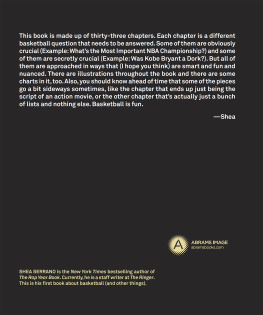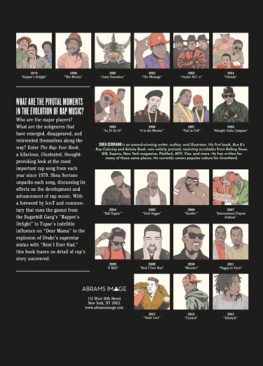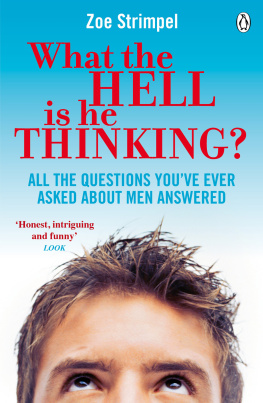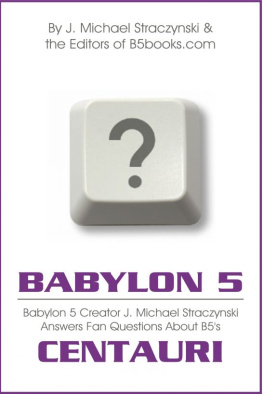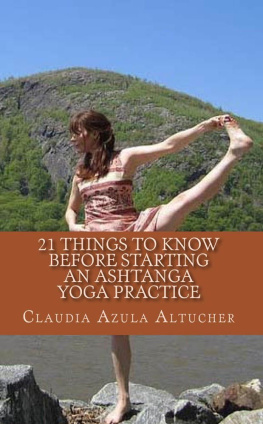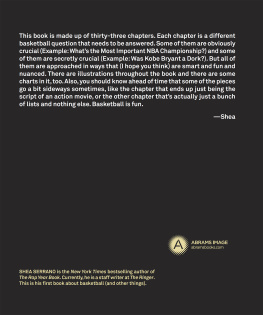Shea Serrano - Basketball (and Other Things): A Collection of Questions Asked, Answered, Illustrated
Here you can read online Shea Serrano - Basketball (and Other Things): A Collection of Questions Asked, Answered, Illustrated full text of the book (entire story) in english for free. Download pdf and epub, get meaning, cover and reviews about this ebook. year: 2017, publisher: Abrams, genre: Romance novel. Description of the work, (preface) as well as reviews are available. Best literature library LitArk.com created for fans of good reading and offers a wide selection of genres:
Romance novel
Science fiction
Adventure
Detective
Science
History
Home and family
Prose
Art
Politics
Computer
Non-fiction
Religion
Business
Children
Humor
Choose a favorite category and find really read worthwhile books. Enjoy immersion in the world of imagination, feel the emotions of the characters or learn something new for yourself, make an fascinating discovery.
- Book:Basketball (and Other Things): A Collection of Questions Asked, Answered, Illustrated
- Author:
- Publisher:Abrams
- Genre:
- Year:2017
- Rating:3 / 5
- Favourites:Add to favourites
- Your mark:
- 60
- 1
- 2
- 3
- 4
- 5
Basketball (and Other Things): A Collection of Questions Asked, Answered, Illustrated: summary, description and annotation
We offer to read an annotation, description, summary or preface (depends on what the author of the book "Basketball (and Other Things): A Collection of Questions Asked, Answered, Illustrated" wrote himself). If you haven't found the necessary information about the book — write in the comments, we will try to find it.
Shea Serrano: author's other books
Who wrote Basketball (and Other Things): A Collection of Questions Asked, Answered, Illustrated? Find out the surname, the name of the author of the book and a list of all author's works by series.
Basketball (and Other Things): A Collection of Questions Asked, Answered, Illustrated — read online for free the complete book (whole text) full work
Below is the text of the book, divided by pages. System saving the place of the last page read, allows you to conveniently read the book "Basketball (and Other Things): A Collection of Questions Asked, Answered, Illustrated" online for free, without having to search again every time where you left off. Put a bookmark, and you can go to the page where you finished reading at any time.
Font size:
Interval:
Bookmark:

1. Are you really going to just answer questions for the introduction to your book?
Yes.
2. Why? Why do that?
It just makes sense to me to do it that way. The entire book is a bunch of different questions getting answered. I think the introduction should be the same.
3. Will you tell me a little about the book?
Sure. The book has 33 chapters. Each chapter is a different basketball question that, as I just mentioned, gets answered. And theyre not traditional, normal, regular questions. Theyre not things like, Was Larry Bird better than Magic Johnson? or whatever. Theyre new questions. Questions that youve (hopefully) not seen before or thought about before. Thats what the book is.
Oh, also: The questions are not related to each other, and what I mean when I say that is the book isnt a thing that has to move front to back. It doesnt flow from one chapter to the next like the way a regular book would. In most cases, you dont have to read one chapter to read a chapter that comes after it. You can jump in wherever.
Oh, another also: Theres a lot of art in here, and also some charts. That part doesnt really need to be explained, though.
4. Is the book all NBA-related stuff?
Pretty much, yes. There are two chapters that are about pickup basketball, and theres one chapter thats about an NBA player whos not an NBA player anymore, and there's a section about basketball players from TV shows and movies, but other than that, yes, its all NBA-related stuff.
5. What did you mean in your answer to the third question when you said, In most cases, you dont have to read one chapter to read a chapter that comes after it? Why the in most cases?
Well, some of the questions ended up requiring answers that were way longer than I was anticipating, and so I just took them and, say, rather than having a single chapter that was 6,000 words, Id take it and break it into two chapters that were 3,000 words. So there are some double chapters in here and even a couple of triple chapters, which is truly dumb.
6. I read your other book, The Rap Year Book, and when I got to the end of it I realized that youd tricked me into reading a book that was secretly the history of rap. Is this one going to be like that? Is this book secretly the history of basketball?
No. Its not that. Its definitely not that. I mean, yes, theres lots of information in here that, after youve read it, youre going to be like, Whoa, I know a lot about basketball now, but thats not the point of the book.
7. Okay, so whats the point of this book then? Does it have a bigger idea hidden away inside of it that I wont realize until Im done reading it?
It does, yes. Im not going to tell you what it is, though.
8. Since its a basketball book, am I going to have to know a lot about stats, or learn a lot about stats? There are stats that get mentioned in the book, definitely. Mostly, its just regular stuff (points per game, blocks per game, things like that), but there are some spots that reference advanced stats to help prove a point or strengthen a point. Heres a quick summary for you:
Player Efficiency Rating (PER): This one uses a calculation of all the pieces of the traditional box score to tell us how efficient a player is. The average NBA player has a PER of 15. All-Star players are usually around, or above, 20. League MVPs tend to hover near 27.5. Anything above 30 is exceptional. The highest-ever PER was 1963 Wilt Chamberlain (31.82).
Box Plus/Minus (BPM): This is a box scorebased measurement that estimates a players performance relative to the league average, and its expressed on a Per 100 Possessions basis. What that means is, okay, if a player has a BPM of 5, that means he is 5 points better than an average player over 100 possessions. Anything above 8 is very good and anything in double-digits is unquestionable. The highest-ever BPM was 2017 Russell Westbrook (15.6).
Value Over Replacement Player (VORP): This converts BPM into an estimate of each players overall contribution to the team. So basically it tells us how valuable a player is versus replacing that player with someone else, or a replacement player, in this case defined as a minimum salary player not in a rotation. Same as BPM, anything above 8 is very good and anything in double-digits is unquestionable. The highest-ever VORP was 2017 Russell Westbrook (12.4).
Win Shares (WS): This is an estimate of the number of team wins a player is responsible for on his team during a particular season. If you add up all the Win Shares on a team, itll equal up to somewhere near however many games that team won that season. Anything near 15 typically means an MVP-caliber season. 1972 Kareem Abdul-Jabbar had the highest WS ever at 25.37.
Now, one of two things just happened in that stats section above. Either you started reading it and were like, Wow, this is interesting. Or you started reading it and were like, Nah, fuck this, and then skipped it. If youre in that second group, all you need to know is that whenever a stat gets mentioned somewhere, high numbers are good and low numbers are bad.
9. The phrase (AND OTHER THINGS) that appears in the title of this bookwhat does it mean?
It means that, on occasion, some of the basketball conversations in here will go sideways for a second. The reason I did it that way is because thats how talking about basketball works for me, which means thats how writing about basketball works for me. I dont think in my life I have ever had a conversation about basketball that traveled in a perfectly straight line. (I suspect it works that same way for a lot of people.) The talks always kind of veer off in different directions, touching on this thing or that thing along the way, before arriving at the conclusion. So, when I was writing the book, I wanted to be careful to keep that feeling intact, and that spirit intact. It just felt natural.
10. You mentioned earlier that this isnt a history book. Was there a cut-off point in time that you decided on?
What I did is I just traveled backward to 1980, the season that Larry Bird and Magic Johnson entered the league, which was the birth of the modern NBA, and then I walked forward from there. There are tiny pieces and footnotes that reference points and events and people from before then, but all of the bigger thoughts and questions and ideas are built up around people and things from 1980 forward.
11. Why did you ask Reggie Miller to write the foreword?
I grew up in San Antonio, and so the Spurs were of course my favorite basketball team growing up and still are my favorite basketball team now. Reggie, thoughReggie was the first basketball player I ever loved. I remember watching him play a game on TV in middle school in the mid-90s and just being absolutely in awe. He was doing all of the things I thought were cool (shooting threes, talking shit, shoving people, etc.), and when youre 13, 14, 15 years old, the only stuff that matters to you is stuff thats cool, you know what Im saying? He was a king to me; a basketball lord, of sorts.
I watched Reggie without fail for a good decade after I found him, all the way up until his retirement in 2005. His last game was a loss to the Pistons in the playoffs. In the final seconds, Pacers coach Rick Carlisle called a timeout so he could take Reggie out so the crowd could cheer for him. Reggie walked toward the bench and raised his hand and everyone was just glowing with love and it was this very touching, very moving scene. And right when it was about to end, Larry Brown, who was coaching the Pistons, called a timeout, too, and the only reason he did was so everyone could keep cheering for Reggie. The camera cut to the crowd and it was person after person after person in tears. Even after all these years, it remains the only time I ever cried while watching someones final game.
Next pageFont size:
Interval:
Bookmark:
Similar books «Basketball (and Other Things): A Collection of Questions Asked, Answered, Illustrated»
Look at similar books to Basketball (and Other Things): A Collection of Questions Asked, Answered, Illustrated. We have selected literature similar in name and meaning in the hope of providing readers with more options to find new, interesting, not yet read works.
Discussion, reviews of the book Basketball (and Other Things): A Collection of Questions Asked, Answered, Illustrated and just readers' own opinions. Leave your comments, write what you think about the work, its meaning or the main characters. Specify what exactly you liked and what you didn't like, and why you think so.


